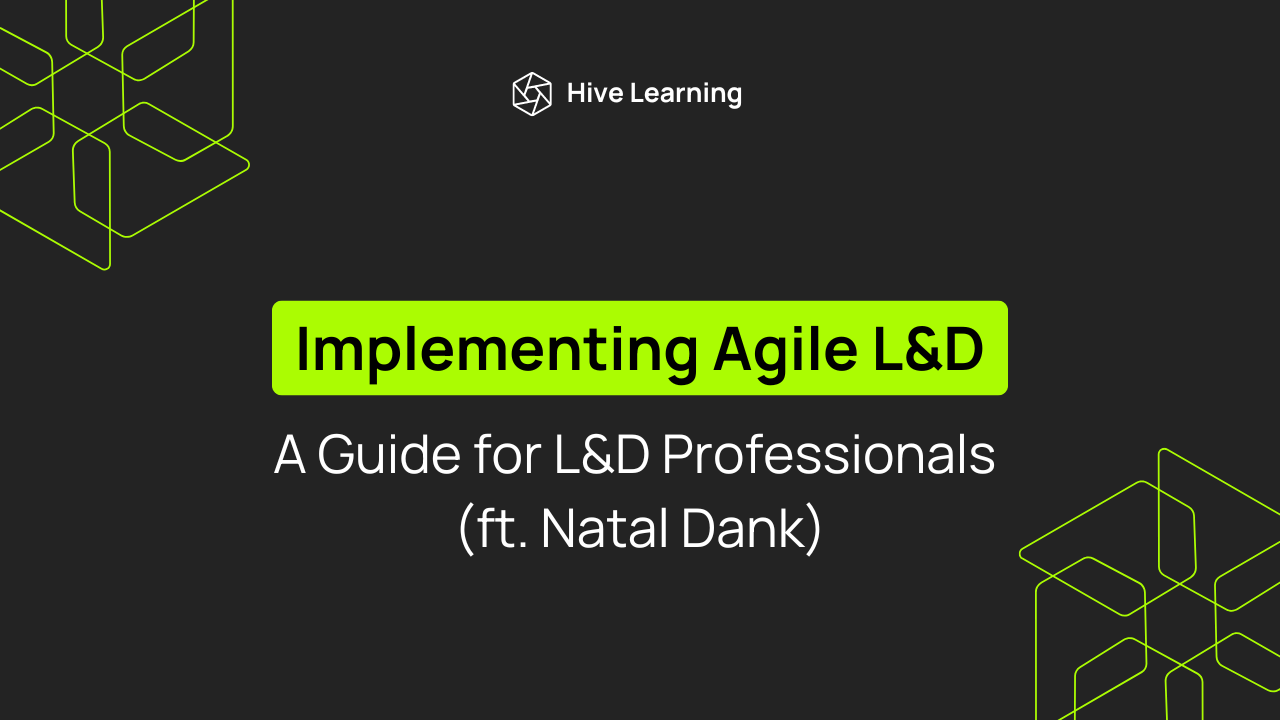Hive Learning’s recent session with Natal Dank offered a deep dive into Agile L&D strategies with a focus on Natal’s newest book Agile L&D, providing valuable insights into how L&D can adapt and thrive in the face of tomorrow’s challenges for the workforce.
Agile, a term that can send shivers down the spine of traditionalists, has become a necessity rather than a choice for businesses looking to remain competitive. However, as Natal Dank points out, Agile should not be feared; it is a disciplined approach to risk management and a pathway to delivering impactful solutions.
The Five Key Principles of Agile L&D
During the session, Natal introduced five principles central to Agile L&D:
- Be Product Led: Start with defining the problem rather than jumping to solutions. Build solutions that are directly aimed at solving the identified problem.
- Work in T-Shaped Teams: Encourage teams to have a broad set of skills (the horizontal bar of the ‘T’) with deep expertise in one area (the vertical bar). This fosters collaboration and innovation.
- Human-Centric Design: Keep the focus on the end-user (your employees). Understand their needs and build learning experiences that resonate with them.
- Experimentation: Test hypotheses and gather data to validate whether the L&D initiatives are on the right track or need adjustment.
- Deliver with Impact: Measure success by tracking business metrics such as job movement, retention, sales outcomes, and user behavior changes, rather than traditional measures like course completion rates.
Implementing Agile L&D: Where to Start?
For L&D teams new to Agile, Natal suggests treating the implementation process as an Agile experiment itself. Start by identifying the problems you want to solve, such as the need for faster solution delivery or better prioritization of complex issues. Set hypotheses and give your team the space to test and learn. However, it’s important to ensure that there is enough capacity to work in Agile ways; otherwise, teams may be caught between conflicting methodologies and targets.
T-Shaped Teams in Practice
Natal provided an example of how T-shaped teams operate effectively. A government agency in Scotland faced challenges with their learning ecosystem and skill identification. By assembling a T-shaped team, they experimented with prototypes and adopted a human-centric design approach. They moved from focusing on a large database of skills to understanding what skills the employees actually needed and how to apply them to solve customer problems. By the end of their agile experiment, they had crafted a learning approach that was not only aligned with the company’s forward-thinking plan but also primed to track real business impacts like improved conversations with external stakeholders and customers.
Measuring Impact and Influencing HIPPOs
To influence HIPPOs (Highest Paid Person’s Opinion), Natal recommends focusing on business problems, testing hypotheses, and tracking lead and lag indicators.
Lead indicators help monitor engagement with the learning initiatives, while lag indicators measure long-term business impacts like retention rates and productivity.
By involving HIPPOs in the process and using data to guide decisions, L&D professionals can align human-centric solutions with business objectives.
Conclusion
Agile is not just a buzzword; it’s a transformational approach that empowers L&D teams to work with precision, relevance, and measurable impact. By adopting the principles discussed by Natal Dank, L&D professionals can position themselves at the forefront of designing learning experiences that truly align with business needs and drive organizational success.
More Articles
Book a demo today
Discover the power of Hive Learning:
Simplify, Streamline, and Succeed
